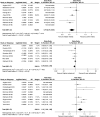Modifiable Lifestyle Factors for Primary Prevention of CKD: A Systematic Review and Meta-Analysis
- PMID: 32868398
- PMCID: PMC7894668
- DOI: 10.1681/ASN.2020030384
Modifiable Lifestyle Factors for Primary Prevention of CKD: A Systematic Review and Meta-Analysis
Abstract
Background: Despite increasing incidence of CKD, no evidence-based lifestyle recommendations for CKD primary prevention apparently exist.
Methods: To evaluate the consistency of evidence associating modifiable lifestyle factors and CKD incidence, we searched MEDLINE, Embase, CINAHL, and references from eligible studies from database inception through June 2019. We included cohort studies of adults without CKD at baseline that reported lifestyle exposures (diet, physical activity, alcohol consumption, and tobacco smoking). The primary outcome was incident CKD (eGFR<60 ml/min per 1.73 m2). Secondary outcomes included other CKD surrogate measures (RRT, GFR decline, and albuminuria).
Results: We identified 104 studies of 2,755,719 participants with generally a low risk of bias. Higher dietary potassium intake associated with significantly decreased odds of CKD (odds ratio [OR], 0.78; 95% confidence interval [95% CI], 0.65 to 0.94), as did higher vegetable intake (OR, 0.79; 95% CI, 0.70 to 0.90); higher salt intake associated with significantly increased odds of CKD (OR, 1.21; 95% CI, 1.06 to 1.38). Being physically active versus sedentary associated with lower odds of CKD (OR, 0.82; 95% CI, 0.69 to 0.98). Current and former smokers had significantly increased odds of CKD compared with never smokers (OR, 1.18; 95% CI, 1.10 to 1.27). Compared with no consumption, moderate consumption of alcohol associated with reduced risk of CKD (relative risk, 0.86; 95% CI, 0.79 to 0.93). These associations were consistent, but evidence was predominantly of low to very low certainty. Results for secondary outcomes were consistent with the primary finding.
Conclusions: These findings identify modifiable lifestyle factors that consistently predict the incidence of CKD in the community and may inform both public health recommendations and clinical practice.
Keywords: alcohol; chronic kidney disease; diet; exercise; lifestyle; smoking.
Copyright © 2021 by the American Society of Nephrology.
Figures




References
-
- Bello A, Levin A, Tonelli M, Okpechi IG, Feehally J, Harris D, et al. ; Global Kidney Health Atlas : A Report by the International Society of Nephrology on the Current State of Organization and Structures for Kidney Care across the Globe, Brussels, Belgium, International Society of Nephrology, 2017
-
- Kelly JT, Campbell KL, Carrero JJ: Primary versus secondary prevention of chronic kidney disease: The case of dietary protein. J Ren Nutr 28: 225–228, 2018. - PubMed
-
- Åkesson A, Weismayer C, Newby PK, Wolk A: Combined effect of low-risk dietary and lifestyle behaviors in primary prevention of myocardial infarction in women. Arch Intern Med 167: 2122–2127, 2007. - PubMed
Publication types
MeSH terms
LinkOut - more resources
Full Text Sources
Other Literature Sources
Medical
Research Materials
Miscellaneous

